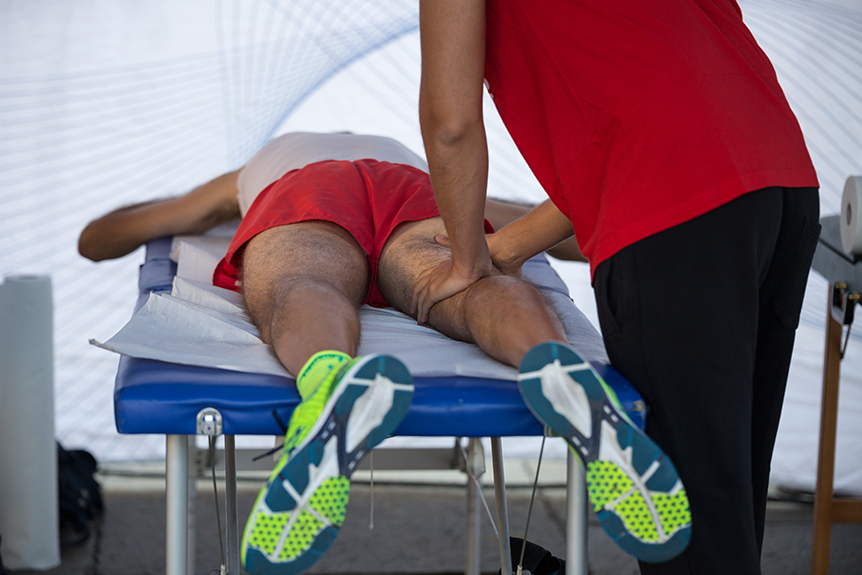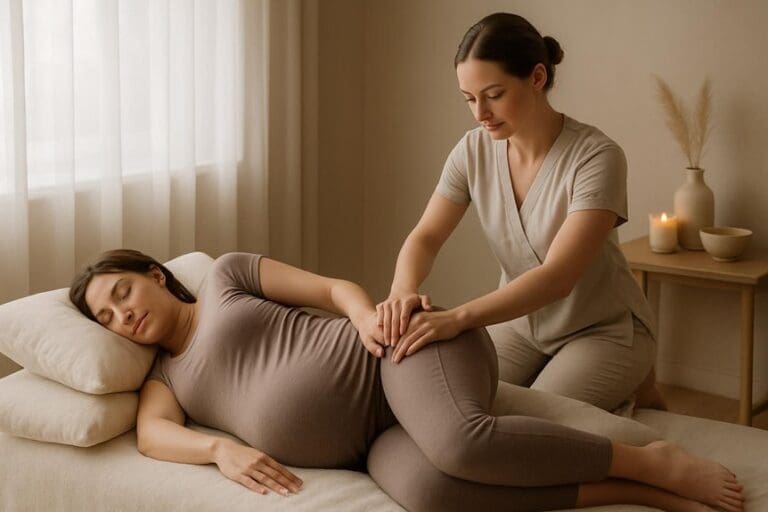To give a performance massage, one assesses the client’s musculoskeletal history and targets stress-prone musculotendinous and fascial structures using techniques like effleurage, petrissage, and deep tissue friction. The practitioner adjusts pressure based on anatomical landmarks and feedback, focusing on circulation, elasticity, and tissue repair. Emphasis is placed on post-massage recovery strategies such as hydration and stretching. Proper preparation, technique selection, and aftercare are critical for safe, effective results. Further guidance enhances precision and outcomes.
Understanding the Purpose of Performance Massage

Why is performance massage integral to athletic performance and recovery? It targets the musculotendinous and fascial structures most susceptible to repetitive stress and microtrauma during athletic activity. By manipulating soft tissues—especially the gastrocnemius, quadriceps, hamstrings, and iliotibial band—therapists enhance local circulation, accelerate metabolic waste removal, and facilitate rapid tissue repair.
Evidence demonstrates that performance massage reduces delayed onset muscle soreness (DOMS) and modulates neuromuscular tone, fostering ideal proprioceptive feedback.
At Spa & Massage clinics, therapists employ anatomically informed techniques to identify and release myofascial adhesions, restoring extensibility and elasticity within the musculature. This targeted approach not only mitigates injury risk but also supports psychological readiness, inviting a sense of confidence and connection between athlete and body—crucial for those seeking both performance and holistic recovery. Research highlights the numerous benefits of sports massage for athletes, including improved flexibility, faster recovery times, and reduced risk of injury.
Preparing the Space and Gathering Supplies
With an understanding of performance massage’s physiological benefits, attention shifts to optimising the treatment environment and assembling the necessary materials. An uncluttered, temperature-controlled space promotes client relaxation and parasympathetic nervous system activation, essential for effective myofascial release.
At Spa & Massage, therapists ensure adequate ambient lighting and minimal auditory distractions, fostering a tranquil yet professional atmosphere.
A supportive, adjustable massage table enables precise access to major muscle groups—hamstrings, quadriceps, gastrocnemius, and deltoids—while maintaining ergonomic posture for the practitioner.
Clean linens, hypoallergenic oils or lotions, and disposable coverings are prepared to accommodate varying skin sensitivities. Our therapists select lubricants that facilitate deep effleurage and petrissage without impeding tissue palpation.
Readily available towels, bolsters, and sanitising agents further guarantee hygiene and tailored anatomical support throughout the session.
Assessing the Client’s Needs and Goals
How does a practitioner determine the most suitable approach for each individual?
At Spa & Massage, the process begins with a structured consultation, gathering information on the client’s physical activity, injury history, and specific musculoskeletal concerns.
Detailed palpation and assessment of soft tissue integrity, joint range of motion, and muscular imbalances reveal the underlying anatomical patterns requiring attention.
Practitioners use evidence-based questioning to clarify whether the client seeks enhanced athletic performance, recovery from strain, or relief from chronic tension.
This targeted evaluation guides the therapist in identifying the precise anatomical structures—such as the hamstrings, quadriceps, or rotator cuff—that will benefit from tailored intervention.
Key Techniques Used in Performance Massage
Following the structured assessment of a client’s needs and goals, practitioners at Spa & Massage implement a repertoire of targeted performance massage techniques designed to address specific musculoskeletal dysfunctions. Techniques such as effleurage facilitate lymphatic drainage and promote vascular perfusion.
While effleurage helps in improving circulation and reducing edema, petrissage mobilizes soft tissues, disrupts adhesions, and enhances myofascial elasticity. Friction techniques are applied with focused pressure to remodel scar tissue and increase the pliability of deep muscles and tendons, particularly in regions prone to repetitive strain.
Cross-fiber manipulation and active release methods are utilized to target hypertonic muscle bands, encouraging neuromuscular re-education and restoring range of motion. Throughout each intervention, therapists maintain anatomical awareness, adjusting pressure and tempo to the client’s physiological feedback, ensuring both efficacy and a deeply nurturing, personal connection.
Areas of Focus for Different Sports and Activities
Targeted performance massage protocols prioritize specific anatomical regions based on athletic demands.
For runners, primary emphasis is placed on the lower extremities—particularly the gastrocnemius, soleus, and plantar fascia—while cyclists benefit from focused work on the lumbar region, gluteal muscles, and hip flexors.
Tennis players often require attention to the forearm extensors, rotator cuff group, and deltoid muscles to address repetitive upper limb loading.
Runners: Legs and Feet
Given the high-impact, repetitive nature of running, the primary regions of concern are the lower extremities, particularly the quadriceps, hamstrings, gastrocnemius, soleus, tibialis anterior, and intrinsic foot muscles.
At Spa & Massage, therapists apply myofascial release and deep tissue techniques to target microtrauma, delayed onset muscle soreness, and adhesion formation common in distance and sprint runners.
Effleurage and petrissage increase circulation and lymphatic drainage, supporting cellular repair.
Specific attention is paid to the plantar fascia and Achilles tendon, recognising their vital role in shock absorption and propulsion.
Therapists recommend post-session stretching and hydration to optimise tissue elasticity.
Regular, focused performance massage in these anatomical areas reduces injury risk, enhances proprioception, and fosters a sense of connectedness and wellbeing essential to the runner’s holistic performance.
Cyclists: Back and Hips
Cycling imposes sustained isometric contractions and repetitive flexion on the lumbar spine and hip complex, leading to overuse patterns in the erector spinae, gluteal muscles, piriformis, and iliopsoas.
At Spa & Massage, therapists focus on these regions to address common issues such as myofascial tightness, trigger points, and limited hip extension.
Deep tissue and neuromuscular techniques are applied along the lumbar paraspinals and gluteal fascia, while gentle stretching mobilizes the hip flexors and lateral rotators.
Therapists may incorporate myofascial release over the sacroiliac area to relieve compensatory tension.
Clients are encouraged to communicate about areas of discomfort, ensuring targeted, effective treatment.
This approach helps restore functional length, alleviate pain, and sustain cycling performance, embodying the attentive care found in all Spa & Massage sessions.
Tennis Players: Arms and Shoulders
How does repeated overhead motion in tennis predispose athletes to specific musculoskeletal demands? The kinetic chain in tennis emphasizes eccentric loading of the rotator cuff, deltoids, and forearm extensors, leading to microtrauma and overuse syndromes, particularly in the supraspinatus and biceps brachii.
Chronic stress on the glenohumeral joint and scapulothoracic musculature often results in restricted range of motion and myofascial trigger points. At Spa & Massage, therapists address these vulnerabilities with targeted deep tissue and myofascial techniques to release adhesions in the pectoralis major, infraspinatus, and triceps brachii.
Gentle joint mobilizations and stretching restore flexibility and proprioception. Performance massage sessions emphasize both preventive care and post-match recovery, reducing inflammation and supporting ideal neuromuscular function.
Individualized aftercare advice enhances ongoing resilience in tennis players.
Aftercare and Recovery Recommendations
Following a performance massage, practitioners at Spa & Massage emphasize the importance of adequate hydration to support lymphatic drainage and metabolic waste removal.
Evidence-based recovery protocols also include gentle stretching and guided myofascial release to optimize muscle repair and minimize delayed onset muscle soreness (DOMS).
These aftercare strategies are designed to promote tissue regeneration and maintain musculoskeletal function.
Post-Massage Hydration Tips
As muscle tissues undergo manipulation during a performance massage, metabolic byproducts and fluids are mobilised throughout the interstitial and vascular compartments. This physiological response can transiently elevate demands on renal and lymphatic systems to facilitate metabolic waste clearance.
At Spa & Massage, therapists advise prompt post-massage hydration, favouring water or electrolyte-rich fluids to support plasma volume restoration and ideal tissue perfusion.
Hydration assists in diluting circulating metabolites, enhancing renal excretion, and mitigating sensations of post-massage fatigue or mild myalgia.
Individuals are encouraged to sip fluids gradually over several hours, respecting the body’s rehydration pace and avoiding overconsumption.
Sufficient fluid intake not only supports cellular recovery but also preserves the suppleness of connective tissues and the integrity of microcirculatory pathways, fostering a holistic post-massage recovery environment.
Muscle Recovery Strategies
While the immediate physiological effects of performance massage include increased microcirculation and enhanced lymphatic drainage, ideal muscle recovery necessitates an integrated aftercare protocol. To optimise repair at the muscular and fascial levels, Spa & Massage therapists recommend a multifaceted approach: gentle active recovery to prevent adhesions, targeted stretching to restore sarcomere length, and application of cold therapy to modulate post-massage inflammation.
Clients are encouraged to monitor delayed onset muscle soreness and utilise self-myofascial release techniques, such as foam rolling, to further facilitate tissue pliability.
Adequate protein intake supports myofibrillar repair, while hydration aids metabolic waste removal from interstitial spaces.
Spa & Massage’s holistic philosophy ensures aftercare is tailored, emphasising anatomical awareness and client-specific guidance to foster deep, lasting recovery beyond the treatment room.
Common Mistakes to Avoid
Although performance massage offers substantial benefits when performed correctly, several common errors can undermine its effectiveness and potentially lead to adverse outcomes.
Excessive pressure applied to sensitive structures—such as the brachial plexus or iliotibial band—may cause tissue irritation or even nerve impingement.
Omitting a thorough assessment of the client’s musculoskeletal history risks exacerbating pre-existing conditions, such as tendinopathies or muscle strains.
Inadequate communication regarding discomfort can result in microtrauma to muscle fibers or connective tissue.
At Spa & Massage, therapists emphasize tailored techniques, evidence-based pressure modulation, and anatomical awareness to avoid these pitfalls.
Skipping post-massage advice, such as hydration or gentle stretching, may impede recovery.
Recognizing and correcting these mistakes cultivates both physical and emotional trust, enhancing therapeutic outcomes and fostering a deeper sense of wellbeing.
Conclusion
Mastering performance massage can transform recovery and performance to almost superhuman levels, providing targeted neuromuscular benefits that traditional relaxation techniques simply cannot achieve. When delivered with anatomical precision and evidence-based protocols, performance massage supports myofascial release, reduces delayed onset muscle soreness (DOMS), and improves tissue elasticity. By adhering to best practices—thorough assessment, tailored techniques, and appropriate aftercare—practitioners empower athletes to maximize physiological resilience and minimize injury risk, securing a critical edge in both training and competition.



